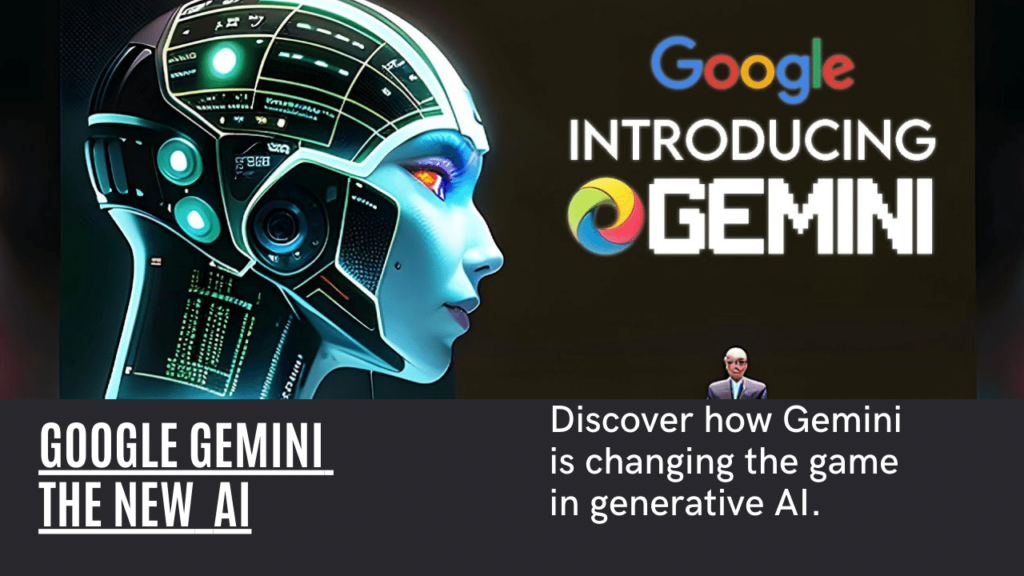Introduction:
In the ever-evolving landscape of artificial intelligence, Google takes a giant leap forward with the introduction of Google Gemini. its groundbreaking generative AI model. In this blog post, we will delve into the intricacies of Google Gemini, exploring its features, capabilities, and the significant impact it promises to have on the AI industry. Join us on this journey as we unravel the potential behind Google’s latest venture and its bid to reclaim the spotlight from competitors like OpenAI.

Google Gemini Emerges: A Strategic Move by Google
As of December 6, 2023, Google has officially launched Gemini, its much-anticipated generative AI model. The unveiling marks the culmination of a substantial internal effort to position Google as a frontrunner in the AI race. Google’s CEO, Sundar Pichai, emphasized the strategic importance of Google Gemini in overcoming the narrative suggesting Google’s lag behind rivals, particularly OpenAI.
Google Gemini is not a one-size-fits-all solution; rather, it comes in three distinct “sizes” named Ultra, Pro, and Nano. Each size is tailored to different requirements, with Nano specifically designed for local processing on devices like smartphones. The phased rollout strategy ensures that users get a taste of Gemini’s capabilities this month, while the most advanced Ultra model is slated for an early 2024 release after thorough internal testing.
Read more about Google Gemini Vs ChatGPT
Google Gemini’s Multimodal Prowess
One of Gemini’s standout features is its multimodal capability, allowing it to process various types of media such as text, images, video, and audio. Google plans to integrate Google Gemini into its popular products gradually, and it’s set to become a central component of Bard, Google’s chatbot, with an advanced version named Bard Advanced on the horizon.
In a recent roundtable discussion, Google executives revealed that Gemini Ultra has surpassed human experts in Massive Multitask Language Understanding (MMLU), scoring an impressive 90.0%. This achievement positions Google Gemini as a frontrunner in processing complex information across diverse subjects like math, history, law, and ethics, outperforming competitors like OpenAI’s GPT-4.
Behind the Scenes of Google Gemini’s Development
Behind the scenes, Google has been actively reshaping its AI landscape to propel Gemini to the forefront. Earlier this year, CEO Sundar Pichai merged Alphabet’s DeepMind unit with the internal AI group, Brain, to accelerate Gemini’s development. The company has also adjusted its approach to research publications to safeguard against rivals commercializing their ideas.
To maintain anonymity and protect proprietary information, we refrain from disclosing specific names and roles within Google’s organizational structure. This ensures a focus on the technological advancements rather than the individuals driving them.
Gemini in Action: Unveiling State-of-the-Art Performance
Gemini’s performance on various benchmarks showcases its state-of-the-art capabilities. Gemini Ultra, in particular, has demonstrated excellence in tasks ranging from natural image, audio, and video understanding to mathematical reasoning. Notably, it has outperformed human experts in MMLU, asserting its dominance in multitask language understanding.
The model’s ability to process different modalities simultaneously, coupled with its sophisticated reasoning, positions Gemini as a versatile and powerful tool. It excels not only in understanding and generating text but also in tasks like image recognition and complex coding scenarios. Gemini’s performance is benchmarked against competitors, demonstrating its superiority in multiple domains.
Gemini’s Role in Advancing Coding Capabilities
One area where Gemini shines is in advanced coding. Its first version exhibits a remarkable understanding of, explanation for, and generation of high-quality code in popular programming languages. This breakthrough has far-reaching implications for developers, enabling them to leverage Gemini for collaborative coding tasks, code design proposals, and faster application development.
The model’s coding capabilities extend to competitive programming scenarios. Google’s presentation of AlphaCode 2, an advanced code generation system powered by a specialized version of Gemini, demonstrates the model’s prowess in solving complex programming problems. This sets the stage for a new era in collaborative coding, where AI becomes an integral part of the development process.
Scalable, Efficient, and Responsible: The Infrastructure Behind Gemini
Google’s commitment to responsible AI is evident in Gemini’s development. The model was trained at scale using Google’s AI-optimized infrastructure, incorporating Tensor Processing Units (TPUs) v4 and v5e. The efficiency of Gemini is highlighted by its faster performance on TPUs compared to earlier models, contributing to the scalability of AI applications.
The announcement of Cloud TPU v5p, Google’s latest AI accelerator system, underscores the company’s dedication to supporting the development and deployment of large-scale AI models. Google emphasizes safety evaluations throughout Gemini’s development, addressing concerns related to bias, toxicity, and potential risks associated with its multimodal capabilities.
Gemini’s Global Rollout: From Pro to Nano
Gemini 1.0 is not confined to the realms of research and development—it’s making its way into the hands of users across the globe. Google is integrating Gemini Pro into its products, with Bard set to utilize a fine-tuned version for advanced reasoning and understanding. Pixel 8 Pro smartphone users will experience Gemini Nano, enabling features like voice recording summarization and Smart Reply in messaging apps.
Developers and enterprise customers can access Gemini Pro starting December 13, opening doors to a new era of AI-driven applications. The phased rollout plan ensures that users at various levels of expertise can harness the power of Gemini for diverse tasks.
Conclusion: The Future Unleashed by Google Gemini
In conclusion, Google Gemini emerges as a transformative force in the realm of generative AI. Its multimodal capabilities, state-of-the-art performance, and advanced coding prowess position it as a frontrunner in the AI landscape. As Gemini rolls out across Google’s products and services, we anticipate a paradigm shift in how AI shapes our daily lives. Google’s commitment to responsibility and safety, coupled with the model’s scalability and efficiency, heralds a future where AI becomes an indispensable tool for innovation, creativity, and progress. The era of Gemini is upon us, and the possibilities it unlocks are boundless. Welcome to the future of AI, as envisioned by Google.
